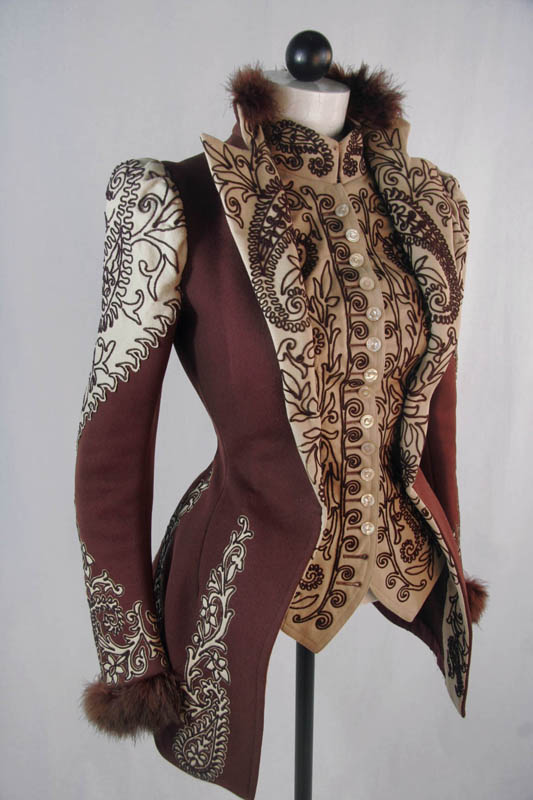At the beginning of this month, Jennifer from Historical Sewing started a 30-day inspiration sharing project. I only commented occasionally, but really liked the idea. So, in retrospect, my entries. For this post, I choose to do all existent pieces. Links to the museum pages are included.
1. Favorite Time Period
Immediately one of the most difficult. I don’t really have 1 favourite, I like different things about different eras and what I like most changes from moment to moment. But, one that has always been high on the list is the second bustle era, ca. 1883-1890. I love the clean lines, dramatic fabrics and shape.
2. Blue
I’ve always had a soft spot for this dress. The fabric is absolutely stunning.
3. 1890’s
One of those eras that needed to grow on me, but I quite like it now. Especially the jackets, those are maybe the best from all time periods.
4. Skirt
The Dutch 18th century chintz skirts are one of my favourite items. This one has a border, using the pattern on the fabric to its fullest.
5. Pleating
Loads of pleating on this Edwardian dress. Pin-tucks in the sleeves and main part, with another pleated drape around the shoulders.
6. Darts/Tucks
I love the tiny gathering on 1840’s and ’50s dresses to give shape.
7. Red or Pink
I’m much more fond of red than pink, which is soon a little too sweet for my taste. I love the fabric on this dress, along with the cut-out design of the bodice.
8. Bells
I’ve always loved the huge dramatic shape of the mid-19th century. My first big historical project was a recreation of this gown.
9. Regency
Although rare, my absolute favorite Regency dresses are the ones made fully of lace. I’ve seen this one in person, and it’s even more stunning in real life.
10. Shoes
Lattice-worked boots are probably my all-time favorite type of shoe. I want these.
11. Sewing Technique
One of the great joys of seeing historical garments in real life is seeing the details. Tiny stitches on the far left of this image, setting the pleat. Tiny cartridge pleats along the embroidered cuffs.
12. Fringe
I’m generally not a big fan of fringe, but the effect on a full dress can be stunning. This fringe I do really like, very creative.
13. Braids
Intricate braiding on the sleeve of a regency spencer. I love details like this.
14. Gathers
Smocking is a way of strategically gathering fabric to form a pattern. This blouse is a gorgeous example.
15. Green
The 18th century does green really well. This is a beautiful example.
16. 1830’s
Another one of those eras that had to grow on me, but I now quite like. This particular dress I’ve always loved though. Those sleeves!
17. Plaid
When Victoria showed an interest in Scotland, using tartan became very popular. Hence, there’s a large number of plaid mid 19th century dresses. This might be my favorite.
18. Reticules
This one was actually first shared by Historical Sewing, and caught my eye. My mother has picked up tatting for about 1,5 year now, so I immediately had to think of her. Also, she’s trying her hand now at recreating this in black, which is really cool!
19. Challenge
This is a close-up of a spencer jacket I’m using as inspiration. My recreation has proven to be a bit of a challenge, and so far the most time-consuming project I’ve ever done, but it’s also starting to be really pretty. My trim won’t be quite as ‘close’ as in the original, but close enough. I also really like how even the original isn’t 100% symmetrical, obviously hand-work, and a challenge to get as perfect as possible!
20. Outdoors
This couldn’t be anything but a large big cloak. Still on my wish-list to make.
21. Undergarments
You’ve got to love Edwardian underwear. It’s the epitome of ruffled and lace undergarments.
22. Lace
I love all types of lace, but black might be my absolute favorite.
23. Black or White
I have a weakness for black dresses in general actually.
24. Parasols
I repeat the black lace comment from above.
25. Edwardian
Not initial my favorite era, but once you look at it more the details are so gorgeous.
26. Ruffles
No era does ruffles like early 1870’s.
27. Oop-sies!
Not so much an oops in the dress as in the display. Museums are generally pretty good at displaying their costumes, and getting even better. Auction houses are more of a hit-and miss. This 1770’s dress looks like it’s got a round crinoline underneath. That counts as a miss.
28. Corset
This one was difficult just because there are so many gorgeous examples. I always love flossing on corsets, and the contrast on this one decided me.
29. Unusual
Maybe not so much unusual as rare, this is one of the few surviving 17th century gowns. It will be on display when I visit Bath in May, so really excited to see it in person.
30. Favorite Costume
This is another really difficult one, but at the moment it’s this chintz ensemble. Probably not worn together originally, but such print mixes were common in parts of the Netherlands in the 18th century. I absolutely love chintz, and very excited for the upcoming exhibition where this will also be on display.






























Prachtige voorbeelden, heel leuk!!
Dankjewel! Plaatjes kijken blijft toch wel een favoriete bezigheid 😉
Lovely selection ! I agree on multiples ones !
Great collection here! And thanks for being a part of our 30 Day of sharing! 🙂
P.S. I ❤ those lattice boots too. 😉
Great collection of photos and details – very enjoyable.
What beautiful choices… particularly that black lace turn-of-the-century gown, which is exquisite!
Glad to have found your blog! 🙂
Thanks. It’s one of my favorites as well!